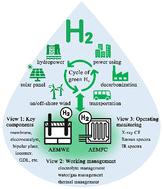当前位置:
X-MOL 学术
›
Chem. Soc. Rev.
›
论文详情
Our official English website, www.x-mol.net, welcomes your
feedback! (Note: you will need to create a separate account there.)
Anion-exchange membrane water electrolyzers and fuel cells
Chemical Society Reviews ( IF 40.4 ) Pub Date : 2022-11-08 , DOI: 10.1039/d2cs00038e Yaxiong Yang 1 , Peng Li 2, 3 , Xiaobo Zheng 4 , Wenping Sun 5, 6 , Shi Xue Dou 3, 7 , Tianyi Ma 2 , Hongge Pan 1, 5
Chemical Society Reviews ( IF 40.4 ) Pub Date : 2022-11-08 , DOI: 10.1039/d2cs00038e Yaxiong Yang 1 , Peng Li 2, 3 , Xiaobo Zheng 4 , Wenping Sun 5, 6 , Shi Xue Dou 3, 7 , Tianyi Ma 2 , Hongge Pan 1, 5
Affiliation

|
Anion-exchange membrane (AEM) water electrolyzers (AEMWEs) and fuel cells (AEMFCs) are technologies that, respectively, achieve transformation and utilization of renewable resources in the form of green hydrogen (H2) energy. The significantly reduced cost of their key components (membranes, electrocatalysts, bipolar plates, etc.), quick reaction kinetics, and fewer corrosion problems endow AEM water electrolyzers and fuel cells with overwhelming superiority over their conventional counterparts (e.g., proton-exchange membrane water electrolyzer/fuel cells and alkaline water electrolyzer/fuel cells). Limitations in our fundamental understanding of AEM devices, however, specifically in key components, working management, and operation monitoring, restrict the improvement of cell performance, and they further impede the deployment of AEM water electrolyzers and fuel cells. Therefore, a panoramic view to outline the fundamentals, technological progress, and future perspectives on AEMWEs and AEMFCs is presented. The objective of this review is to (1) present a timely overview of the market development status of green hydrogen technology that is closely associated with AEMWEs (hydrogen production) and AEMFCs (hydrogen utilization); (2) provide an in-depth and comprehensive analysis of AEMWEs and AEMFCs from the viewpoint of all key components (e.g., membranes, ionomers, catalysts, gas diffusion layers, bipolar plates, and membrane electrode assembly (MEA)); (3) summarize the state-of-the-art technologies for working management of AEMWEs and AEMFCs, including electrolyte engineering (electrolyte selection and feeding), water management, gas and heat management, etc.; (4) outline the advances in monitoring the operations of AEMWEs and AEMFCs, which include microscopic and spectroscopic techniques and beyond; and (5) present key aspects that need to be further studied from the perspective of science and engineering to accelerate the deployment of AEMWEs and AEMFCs.
中文翻译:

阴离子交换膜水电解槽和燃料电池
阴离子交换膜(AEM)水电解槽(AEMWEs)和燃料电池(AEMFCs)分别是实现可再生资源绿色氢(H 2)能源转化利用的技术。其关键部件(膜、电催化剂、双极板等)的成本显着降低、反应动力学快以及腐蚀问题更少,这些都赋予 AEM 水电解槽和燃料电池相对于传统同类产品的压倒性优势(例如,质子交换膜水电解槽/燃料电池和碱性水电解槽/燃料电池)。然而,我们对AEM装置的基本了解,特别是在关键部件、工作管理和运行监控方面的局限性限制了电池性能的提升,并进一步阻碍了AEM水电解槽和燃料电池的部署。因此,概述了 AEMWE 和 AEMFC 的基本原理、技术进步和未来前景的全景图。本综述的目的是(1)及时概述与 AEMWE(制氢)和 AEMFC(氢利用)密切相关的绿色氢技术的市场发展状况;(2) 从所有关键组件的角度对 AEMWE 和 AEMFC 进行深入和全面的分析(例如,膜、离聚物、催化剂、气体扩散层、双极板和膜电极组件 (MEA));(3) 总结AEMWEs和AEMFCs工作管理的最新技术,包括电解质工程(电解质选择和供给)、水管理、气体和热量管理等;(4) 概述监测 AEMWE 和 AEMFC 运行的进展,包括显微和光谱技术等;(5) 从科学和工程的角度提出需要进一步研究的关键方面,以加速 AEMWE 和 AEMFC 的部署。
更新日期:2022-11-08
中文翻译:

阴离子交换膜水电解槽和燃料电池
阴离子交换膜(AEM)水电解槽(AEMWEs)和燃料电池(AEMFCs)分别是实现可再生资源绿色氢(H 2)能源转化利用的技术。其关键部件(膜、电催化剂、双极板等)的成本显着降低、反应动力学快以及腐蚀问题更少,这些都赋予 AEM 水电解槽和燃料电池相对于传统同类产品的压倒性优势(例如,质子交换膜水电解槽/燃料电池和碱性水电解槽/燃料电池)。然而,我们对AEM装置的基本了解,特别是在关键部件、工作管理和运行监控方面的局限性限制了电池性能的提升,并进一步阻碍了AEM水电解槽和燃料电池的部署。因此,概述了 AEMWE 和 AEMFC 的基本原理、技术进步和未来前景的全景图。本综述的目的是(1)及时概述与 AEMWE(制氢)和 AEMFC(氢利用)密切相关的绿色氢技术的市场发展状况;(2) 从所有关键组件的角度对 AEMWE 和 AEMFC 进行深入和全面的分析(例如,膜、离聚物、催化剂、气体扩散层、双极板和膜电极组件 (MEA));(3) 总结AEMWEs和AEMFCs工作管理的最新技术,包括电解质工程(电解质选择和供给)、水管理、气体和热量管理等;(4) 概述监测 AEMWE 和 AEMFC 运行的进展,包括显微和光谱技术等;(5) 从科学和工程的角度提出需要进一步研究的关键方面,以加速 AEMWE 和 AEMFC 的部署。











































 京公网安备 11010802027423号
京公网安备 11010802027423号